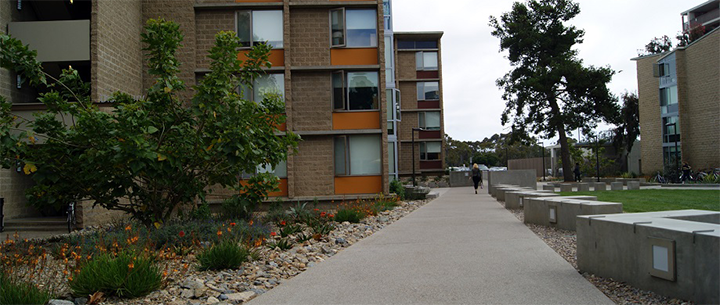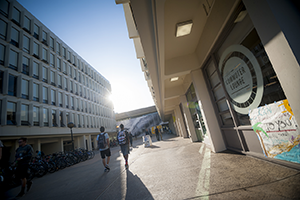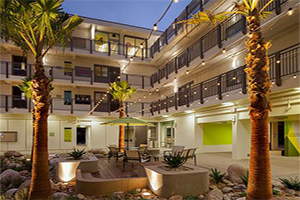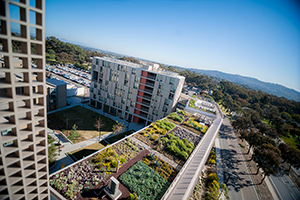
Residence Life Communities
Welcome to the vibrant residential life communities of Revelle College.
Residence Halls
First Year Residents live in one of our 3 Residence Halls: Blake, Argo, and the Fleets. Learn more about them below.
Amenities
- Washers and Dryers on each floor (Blake and Argo) or building (Fleet)
- Central study lounges
- Cable jack (basic cable included)
- Wireless Internet
Argo Hall
Argo Hall

Argo is a six-story building which accommodates approximately 350 students, with a Resident Assistant on each floor. Each of the five residential floors has six suites and each suite houses between 12 and 16 students (primarily in triple rooms) who share two lounge areas and a bathroom.
Argo Hall is named after a converted Navy rescue ship commissioned in 1960 by Scripps Institution of Oceanography (aka Scripps Institution) at UC San Diego and used for a decade. Roger Revelle gave a speech at the ceremony of the commissioning and reminded everyone that the name was chosen from the Greek mythological vessel; Jason's Argo sailed from Greece to Colchis in search of the golden fleece, this being the first oceanographic expedition.
Blake Hall
Blake Hall

Blake is a four-story building which accommodates approximately 180 students, with a Resident Assistant on floors 2 and 3. All residential floors have six suites and each suite houses between 12 and 16 students (primarily in triple rooms) who share two small lounge areas and a bathroom.
Blake Hall is named after the USCGS Steamer Blake, a coast survey ship under the command of J.E. Pillsbury. Measurements of the Gulf Stream were made between 1885 and 1890. This ship was also used by Alexander Agassiz. He began a twenty-five year coral reef study in the Caribbean and visited the Scripps Institution in the early days.
The Fleet
The Fleet

Atlantis, Beagle, Challenger, Discovery, Galathea and Meteor Hall
The Fleet are named after the six infamous ships that aided in research and oceanic exploration. These six buildings were the first residential facilities constructed at UCSD. They have single gender suites which alternate male and female throughout the building. Each building houses approximately 80 students and one Resident Assistant. The Fleet Residence Halls were renovated in 2010.
The Atlantis, a 142 foot sailing ship with a powerful auxiliary engine, made its first trip in 1831, and was the first ship of Scripps' sister institution, the Woods Hole Oceanographic Institution, Woods Hole, Massachusetts. Many of Scripps' oceanographers sailed on this ship which worked throughout the Atlantic and Caribbean areas, as well as the southeast Pacific and Mediterranean.
Charles Darwin joined the Beagle as a member of a surveying expedition. He was the naturalist and geologist in the group. For five years (1831-1836) he cruised the Atlantic and Pacific. Darwin stated later that this cruise determined the course of his career and was a factor in the development of his theory of evolution. Original volumes of the cruise are in the Special Collections of the UC San Diego Geisel Library, the Hill Collection of Voyages.
The HMS Challenger was the first around the world oceanographic expedition. It was a 236 foot naval corvette which circumnavigated the globe in a long three and a half year voyage from 1872 to 1876. Wyville Thomson headed the civilian scientific staff. Over fifty volumes were produced as reports from this expedition, and these are all at the Scripps Institution of Oceanography Library.
The first Discovery, a British research vessel, took Robert Falcon Scott to the Antarctic in 1900. In 1910, on its second trip, the same ship delivered Scott and his group to the South Pole. Scott, with others reached the pole on foot only to find that Amundsen had been there a month earlier. Sir Charles Wright, a past Director of Scripps' Marine Physical Laboratory, went with Scott on the first expedition. The ship has been restored and is moored on the Thames River in England.
The Galathea was a Scandinavian research vessel financed by contributions from the people of Denmark, Norway and Sweden. From 1950 to 1952 it circumnavigated the globe and explored deep oceanic trenches. The Galathea Deep in the Philippine Trench is named after this ship.
The Meteor was a German ship renowned for making the first large cruise in a single ocean. From 1925 to 1927 Dr. Alfred Merz and Dr. Georg Wüst made a systematic investigation of an extensive area of the Atlantic, which was known as the German Atlantic expedition.
Apartments
Our Continuing Residents move over to our Apartment style living spaces in the Charles David Keeling Apartments. Learn more about this space below.
Charles David Keeling Apartments
Amenities
- Telephone jack in the room
- Cable jack (basic cable included)
- Wireless Internet
- Study Lounges and Rooftop Garden
- Central Laundry Facility on each floor in the West Bar
Lili'uokalani, Hawai’i, Moloka’i, Kaho’olawe, Maui, Lana’I, O’ahu, Ni’ihau and Kaua’i

The Keeling Apartments are located in the south west corner of the Revelle Campus. There are nine communities within the Keeling Apartments with one Resident Assistant per community. These apartments are designated for Revelle continuing students. Each apartment is designed to house six students in four bedrooms (two single rooms and two double rooms).
The Keeling Apartments were named after Charles David Keeling, a scientist who worked with Roger Revelle at Scripps Institution of Oceanography (SIO). Keeling is most famous for his recording of the progressive buildup of carbon dioxide in the Earth's atmosphere. From his research came the Keeling Curve, which first alerted the world to the possibility of global warming. He conducted his research at the Mauna Loa Observatory on the big island of Hawaii. It is because of this connection to Hawaii that the nine communities in the Keeling Apartments are named after the eight Hawaiian Islands and Lili'uokalani is named after the last sovereign monarch of the Hawaiian Kingdom.
